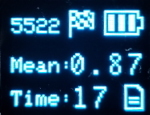I do not see the problem of calling a fixed base a fixed base obtained by different procedures. Simply in some cases the base has relative coordinates and in others absolute. The technician should know the difference. For my way of thinking and not complicate the use of the base mode, it is that I suggested what was proposed in #327. In almost all professional controllers, the coordinates of the mark that correspond to the base point, whether relative or absolute, are saved and in another session they are used from a list of points. In each session you enter cane height and it is ready. I don't think it is necessary to make differences depending on where the fixed base coordinates are obtained from. I would like you to give what was stated in #327 a chance. Greetings to all


Subject of the issue
The UI for the WiFi Base Configuration page is confusing and needs a little redesigning
Your workbench
Facet with v2.5-Sep 19 2022
Current State
There are multiple overlapping and intertwined conversation threads in various issues regarding inconsistent details of the UI and functionality of the WiFi Base Configuration page.
Aspects of the current UI are confusing.
Proposed Behavior
Fully recognize the three distinct techniques to determine the fixed locations the ZED will used for the physically fixed base and build the UI accordingly.
(a) Enter Base Coordinates (currently called "Fixed")
(a1) Geodetic - There are 3 required and 2 optional fields. Prepopulate the 5 fields if there are values in the current profile. User must enter 3: LLh. h is height above ellipsoid. (no geoid correction). User optionally enters antenna height and antenna offset. Assume zero if no entry.
When the user is finished, save all five values in the current profile. Zero out the ECEF XYZ value in the current profile.
(a2) ECEF - there are three entry fields for XYZ that the user must enter. If the ECEF coordinates in the current profile are non-zero, prepopulate the entry fields with the profile values.
When the user is finished, save the XYZ values in the current profile. Zero out the five LLh/AH/AO values in the current profile.
(b) Use Current Coordinates. The current location fix is copied into the ZED and it begins transmitting RTCM without the survey-in process and delay. This is useful for folks who are used to turning GNSS receivers on, setting them up properly to get accurate locations, and giving them time to determine their location. Prominently displaying the LLh coordinates that will be (were?) sent to the ZED is useful for the user to write down or screen-shot for future use, say setting up the base the next day. Note if the ZED's LLh are determined from the NMEA,, it's important to remove the ZED's crude geoid correction so we are using HAE.
The only UI input in this section are an optional antenna height and antenna offset. They are assumed to be zero if the user does not enter non-zero values.
The LL coordinates sent to the ZED are stored in the current profile. The HAE of the mark ( HAE of the APC - antenna height - antenna offset) is stored in the current profile. The antenna height is stored in the current profile. The antenna offset is stored in the current profile.
The current ECEF coordinates are stored in the current profile.
(c) Survey-In, in which the ZED is commanded to use its internal algorithm to wait for a fix (ha that word again) that meets certain parameters. This is a very useful mode for beginners that setup the base, turn is on, wait for it to transmit, and they go roving. This is a less useful mode for experienced users.
The only UI input for the user to change is the parameters that the ZED uses to determine when it's fix is good enough.